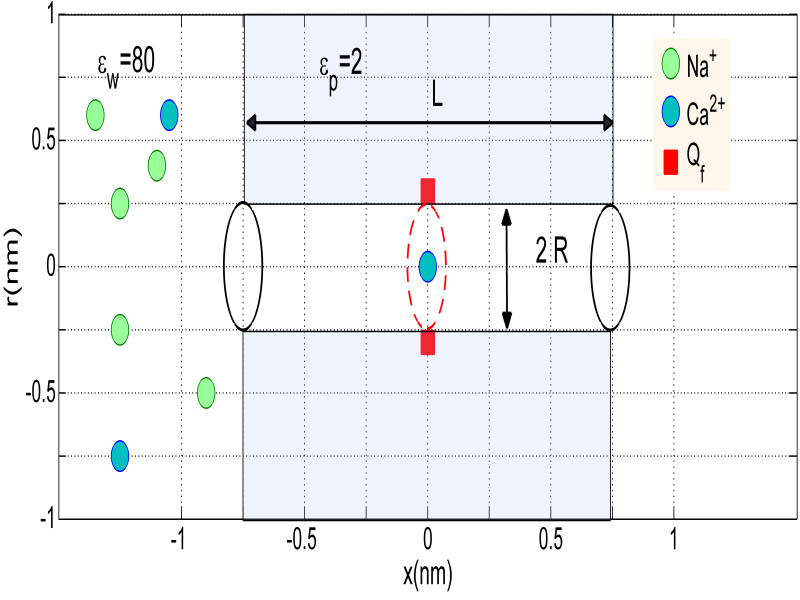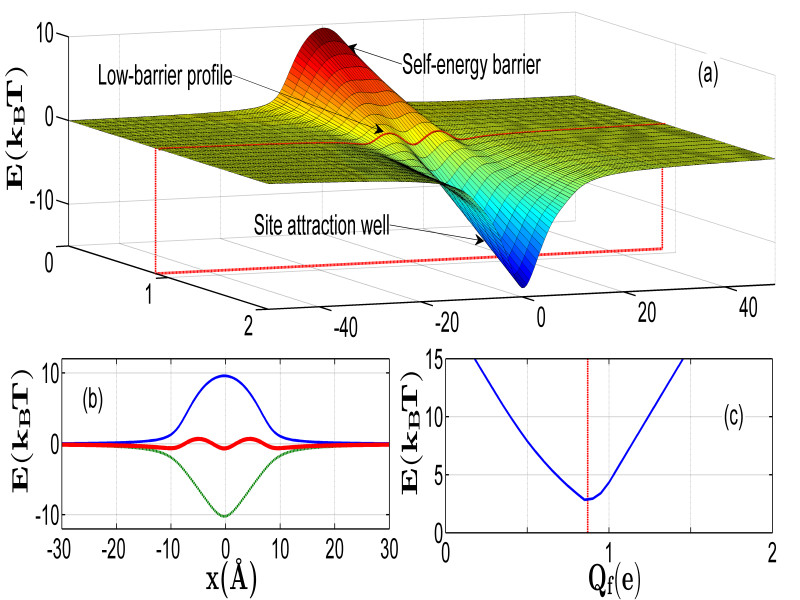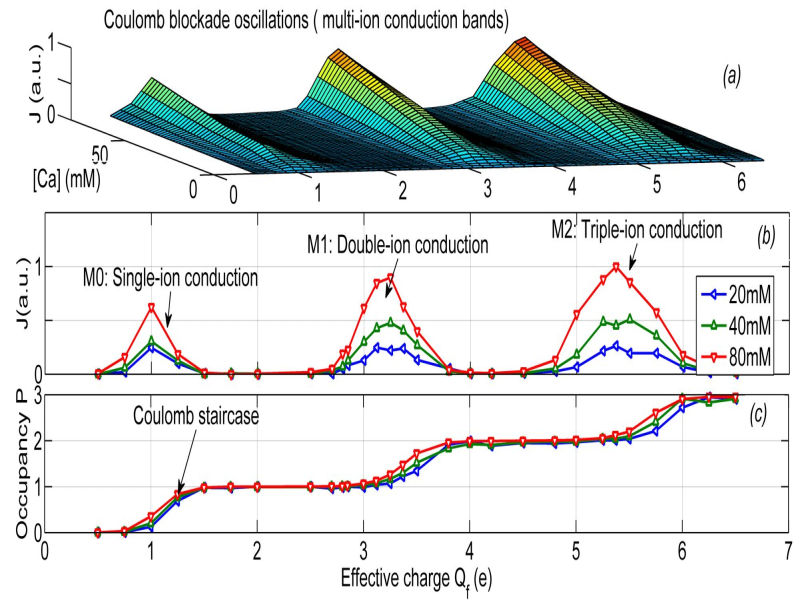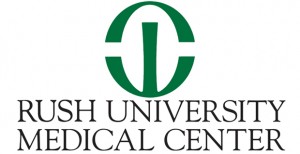Ionic Coulomb blockade in biological ion channels
Biological ion channels are protein nanotubes that embedded in, and passing through, the bilipid membranes of cells. Physiologically, the ion channels are of crucial importance in that they allow ions to pass into and out of cells, fast and efficiently, though in a highly selective way.
The Ionic Coulomb blockade (ICB) phenomenon appears in low-capacitance electrodiffusion systems and arises from the discreteness of electrical charge, the strong electrostatic interaction, and an electrostatic exclusion principle. ICB provides a straightforward explanation of numerous observed and modelled conduction and valence selectivity phenomena, including the anomalous mole fraction effect and the calcium conduction bands.
ICB and resonant conduction are quite similar to electronic Coulomb blockade and resonant tunnelling in quantum dots. The same considerations may also be applicable to other kinds of channel, as well as to charged artificial nanopores.

|
 |
 |
| Generic self-consistent electrostatic model of calcium ion channel: "charged hole in the wall", reproduce features or real ion channels. | Resonant Calcium conduction occurs at optimal fixed charge value when diffusion is barrier-less. | Coulomb blocade oscillation of Calcium conduction and occupancy presents fundamental electrostatic phenomenon. |
Our central aim is to understand conduction and selectivity in biological ion channels and artificial nanopores, taking advantage of the insights afforded by the ICB, combined with the discreteness of the ions and their hydration shells.
The theoretical and numerical results are tested against earlier observations and new experimental measurements planned on mutation transformations in bacterial sodium ion channels.
Our detailed objectives are -
- To develop a detailed analytic model of ICB oscillations, able to account for the resonant conduction observed in charged biological and artificial nanopores. The model is inspired directly by closely analogous tunnelling phenomena that control conduction in tunnel diodes and quantum dots. It is expected to explain valence-selective ionic blockade and conduction in calcium and sodium ion channels.
- Hence, to develop a unified theoretical model of selectivity based on ICB, stochastic dynamics, and the discreteness ofthe hydration shells around the ion. We thus aim to achieve a structure-to-function explanation of both valence and alike selectivity, for voltage-gated calcium and sodium channels, and artificial nanopores, over a broad range of parameters.
- To determine the features, mechanisms and sequences of mutation-induced selectivity transformations in the bacterial sodium channels NaChBac, experimentally, using site-directed mutagenesis to scan the fixed charge at the selectivity filter over a broad range. We will connect these transformations with ICB oscillations related to the fixed negative charge at the selectivity filter.
- To use molecular dynamics (MD) simulations for determination of the sequences of mutation-induced transformations that occur with structure, fixed charge and ionisation state of the mutated loci for the bacterial sodium channels NaChBac and their mutants; and to compare with the results of the experiments and Brownian dynamics (BD) simulations.
- To apply the unified theoretical model of selectivity to charged artificial nanotubes, in order to predict the selectivity type from their structure. We will explain and predict the order and sequence of the conduction and selectivity transformations that occur as geometrical parameters and the fixed charge of a nanotube are varied.
These challenging objectives are to be attained through coordinated, interdisciplinary, endeavour combining the expertise of the groups in Lancaster Physics (Nonlinear and Biomedical Physics, NBP), Lancaster Health and Medicine (Biomedical and Life Sciences, BLS), and the Centre for Scientific Computing in Warwick University, guided and advised by our long-term collaborator Bob Eisenberg in Chicago Rush University. The joint research is carried out under EPSRC-funded Project (grant No EP/M015831/1)"Ionic Coulomb blockade oscillations and the physical origins of permeation, selectivity, and their mutation transformations in biological ion channels" .
Recent publications
- Kaufman, I. K. & McClintock, P. V. E., Nanopores: Ionic Coulomb blockade, Nature Materials (News \& Views). 15, p. 825-826, 2016.
- Kaufman, I.K., Luchinsky, D.G., Gibby, W.A.T., McClintock, P.V.E., Eisenberg, R.S., Ptative resolution of the EEEE selectivity paradox in L-type Ca2+ and bacterial Na+ biological ion channels, Journal of Statistical Mechanics: Theory and Experiment, 2016.
- Kaufman, I.K., McClintock, P.V.E., Eisenberg, R.S, Coulomb blockade model of permeation and selectivity in biological ion channels, New Journal of Physics. 17, 8, 2015.
- IK Kaufman, W Gibby, DG Luchinsky, PVE McClintock, RS Eisenberg, Coulomb blockade oscillations in biological ion channels, Noise and Fluctuations (ICNF), International Conference on, 1-4, 2015.
- Gibby, W., Luchinsky, D., Kaufman, I.K., McClintock, P.V.E., Stefanovska, A., Eisenberg, R.S., Insights into ion channel selectivity with ionic Coulomb Blockade, Biophysical Journal 110 (3 Supp), 343a,2016.
- Kaufman, I., Luchinsky, D.G., Tindjong, R., McClintock, P.V.E., Eisenberg, R.S., Energetics of discrete selectivity bands and mutation-induced transitions in the calcium-sodium ion channels family, Physical Review E. 88, 5, 2013.
- Kaufman, I., Tindjong, R., Luchinsky, D. G., McClintock, P. V. E. & Eisenberg, R. S., Resonant multi-ion conduction in a simple model of calcium channels Noise and Fluctuations (ICNF), 2013 22nd International Conference IEEE, 4 p, 2013.
- Kaufman, I., Luchinsky, D.G., Tindjong, R., McClintock, P.V.E., Eisenberg, R.S., Multi-ion conduction bands in a simple model of calcium ion channels, Physical Biology. 10, 2, 2013.
Online Presentations
References
- Krems, M. and Di Ventra, M., Ionic Coulomb blockade in nanopores, Phys. Condens. Matter, 25, 065101, 2013.
- Zhang J., Kamenev A. and Shklovskii B. I., Ion exchange phase transitions in water-filled channels with charged walls, Phys. Rev. E 73, 051205, 2006.
- von Kitzing, E., A Novel Model for Saturation of Ion Conductivity in Transmembrane Channels, in: Membrane Proteins: Structures, Interactions and Models: Proceedings of the Twenty-Fifth Jerusalem Symposium on Quantum Chemistry and Biochemistry Held in Jerusalem, Israel, May 18--21,1992, 1992
- Nonner, Wolfgang, and Bob Eisenberg., Ion permeation and glutamate residues linked by Poisson-Nernst-Planck theory in L-type calcium channels, Biophysical Journal 75, 3, 1287-1305, 1998.




